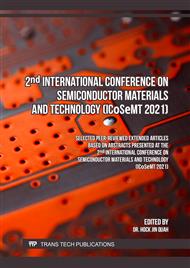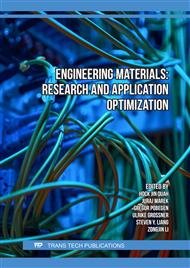[1]
S.R. Sriram, B. Bindu, Hot Carrier Reliability in 45 nm Strained Si/relaxed Si1−xGex CMOS Based SRAM Cell, 2018 15th IEEE India Council International Conference (INDICON), 2018, pp.1-6.
DOI: 10.1109/indicon45594.2018.8987152
Google Scholar
[2]
D. Mohanta, S.S. Singh, Study of Electrical Parameters of Strained Si PMOS with High k Dielectric Material Using TCAD, 2022 IEEE VLSI Device Circuit and System (VLSI DCS), 2022, pp.244-247.
DOI: 10.1109/vlsidcs53788.2022.9811476
Google Scholar
[3]
K. Arimoto, T. Fujisawa, D. Namiuchi, A. Onogawa, Y. Sano, D. Izumi, J. Yamanaka, K.O. Hara, K. Sawano, K. Nakagawa, Dependences of the hole mobility in the strained Si pMOSFET and gated Hall bars formed on SiGe/Si(110) on the channel direction and the strained Si thickness, Journal of Crystal Growth 571 (2021) 126246.
DOI: 10.1016/j.jcrysgro.2021.126246
Google Scholar
[4]
T. Bentrcia, F. Djeffal, M. Chahdi, Performance evaluation of nanoscale halo dual-material double gate SiGe MOSFET using 2-D numerical simulation, Materials Today: Proceedings 20 (2020) 348-355.
DOI: 10.1016/j.matpr.2019.10.073
Google Scholar
[5]
A.F. Abd Rahim, N.S.I. Mohamad Shuhaimi, N.S. Mohd Razali, R. Radzali, A. Mahmood, I.H. Hamzah, M.F. Mohamed Packeer, Dimensional effect of doped porous Ge using SILVACO TCAD simulation for potential optoelectronics application, ESTEEM Academic Journal 17 (2021) 78-88.
DOI: 10.17576/jsm-2022-5112-17
Google Scholar
[6]
K.S.K. Kwa, S. Chattopadhyay, S.H. Olsen, L.S. Driscoll, A.G.O. Neill, Optimisation of channel thickness in strained Si/SiGe MOSFETs, ESSDERC '03. 33rd Conference on European Solid-State Device Research, 2003., 2003, pp.501-504.
DOI: 10.1109/essderc.2003.1256923
Google Scholar
[7]
P. Hashemi, T. Ando, K. Balakrishnan, S. Koswatta, L. Kam-Leung, J.A. Ott, K. Chan, J. Bruley, S.U. Engelmann, V. Narayanan, E. Leobandung, R.T. Mo, High performance PMOS with strained high-Ge-content SiGe fins for advanced logic applications, 2017 International Symposium on VLSI Technology, Systems and Application (VLSI-TSA), 2017, pp.1-2
DOI: 10.1109/vlsi-tsa.2017.7942468
Google Scholar
[8]
A. M. Taberkit, A. Guen-Bouazza, M. Horch, The importance of using dual channel heterostructure in strained P-MOSFETs, 2018 International Conference on Communications and Electrical Engineering (ICCEE), 2018, pp.1-5.
DOI: 10.1109/ccee.2018.8634492
Google Scholar
[9]
L. Gomez, P. Hashemi, J.L. Hoyt, Enhanced Hole Transport in Short-Channel Strained-SiGe p-MOSFETs, IEEE Transactions on Electron Devices 56(11) (2009) 2644-2651.
DOI: 10.1109/ted.2009.2031043
Google Scholar
[10]
S.S. Mahato, A.R. Saha, Reliability Issues in strained-Si MOSFETs, IETE Journal of Research 53(3) (2007) 277-284.
DOI: 10.1080/03772063.2007.10876141
Google Scholar
[11]
A. Kumari, S. Kumar, Analysis of Nanoscale Strained-Si/SiGe MOSFETs including Source/Drain Series Resistance through a Multi-iterative Technique, 2014 27th International Conference on VLSI Design and 2014 13th International Conference on Embedded Systems, 2014, pp.427-432.
DOI: 10.1109/vlsid.2014.80
Google Scholar
[12]
A.F. Abd Rahim, N.Z. Baharom, R. Radzali, A. Mahmood, M. Mohamed Zahidi, M. Jumidali, Low Dimensional Ge Island on Si for Visible Metal-Semiconductor-Metal Photodetector, ESTEEM Academic Journal 14 (2018) 1-11.
DOI: 10.1051/epjconf/201716201062
Google Scholar
[13]
I. Aberg, C. Cait Ni, J.L. Hoyt, Ultrathin-body strained-Si and SiGe heterostructure-on-insulator MOSFETs, IEEE Transactions on Electron Devices 53(5) (2006) 1021-1029.
DOI: 10.1109/ted.2006.871847
Google Scholar
[14]
G.K. Dalapati, S. Chattopadhyay, K.S.K. Kwa, S.H. Olsen, Y.L. Tsang, R. Agaiby, A.G.O. Neill, P. Dobrosz, S.J. Bull, Impact of strained-Si thickness and Ge out-diffusion on gate oxide quality for strained-Si surface channel n-MOSFETs, IEEE Transactions on Electron Devices 53(5) (2006) 1142-1152.
DOI: 10.1109/ted.2006.872086
Google Scholar
[15]
D.J. Paul, Si/SiGe heterostructures: from material and physics to devices and circuits, Semiconductor Science and Technology 19(10) (2004) R75-R108.
DOI: 10.1088/0268-1242/19/10/r02
Google Scholar
[16]
I. Saad, B.S. Chan, M.Z. Hamzah, N. Bolong, K.A. Mohamad, Breakdown Voltage Reduction Analysis with Adopting Dual Channel Vertical Strained SiGe Impact Ionization MOSFET (VESIMOS), International Journal of Simulation- Systems, Science and Technology- IJSSST 15(2) (2014) 40-45
DOI: 10.5013/ijssst.a.15.02.06
Google Scholar
[17]
M. Shima, T. Ueno, T. Kumise, H. Shido, Y. Sakuma, S. Nakamura, <100> channel strained-SiGe p-MOSFET with enhanced hole mobility and lower parasitic resistance, 2002 Symposium on VLSI Technology. Digest of Technical Papers (Cat. No.01CH37303), 2002, pp.94-95.
DOI: 10.1109/vlsit.2002.1015403
Google Scholar
[18]
M.J. Kumar, V. Venkataraman, S. Nawal, Impact of Strain or Ge Content on the Threshold Voltage of Nanoscale Strained-Si/SiGe Bulk MOSFETs, IEEE Transactions on Device and Materials Reliability 7(1) (2007) 181-187.
DOI: 10.1109/tdmr.2006.889269
Google Scholar
[19]
C.N. Chleirigh, N.D. Theodore, H. Fukuyama, S. Mure, H. Ehrke, A. Domenicucci, J.L. Hoyt, Thickness Dependence of Hole Mobility in Ultrathin SiGe-Channel p-MOSFETs, IEEE Transactions on Electron Devices 55(10) (2008) 2687-2694.
DOI: 10.1109/ted.2008.2003228
Google Scholar
[20]
C. Vedatrayee, B. Mukhopadhyay, P.K. Basu, A compact drift-diffusion current model of strained-Si-Si1-xGex MOSFETs, 2009 4th International Conference on Computers and Devices for Communication (CODEC), 2009, pp.1-4.
Google Scholar



